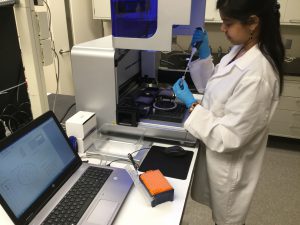New genetic analysis center at UT to accelerate research in disease prevention, detection and treatment
May 15th, 2018 by Christine BillauThe University of Toledo Women & Philanthropy Genetic Analysis Instrumentation Center will be unveiled 6 p.m. Thursday, May 17 with a ceremony in Health Education Building Room 100 on Health Science Campus, followed by tours of the facility located on the second floor.
The center, which increases the capability of UT researchers in the College of Medicine and Life Sciences to develop preventative, diagnostic and treatment strategies for diseases such as cancer and heart disease, was created with the help of nearly $60,000 from Women & Philanthropy, the largest grant ever awarded by the volunteer organization that supports UT initiatives.
 “This is a critical investment that advances the research mission of UT,” said Marcy McMahon, the chair of Women & Philanthropy. “We believe it will serve to improve public health and retain and attract talented scientists dedicated to curing diseases.”
“This is a critical investment that advances the research mission of UT,” said Marcy McMahon, the chair of Women & Philanthropy. “We believe it will serve to improve public health and retain and attract talented scientists dedicated to curing diseases.”
“The center truly transforms work in the emerging field of molecular diagnostics,” said Dr. David Kennedy, assistant professor in the Department of Medicine and co-director of the UT Women & Philanthropy Genetic Analysis Instrumentation Center. “By saving valuable time and using a high-quality process, it sets new standards for molecular testing and incorporates all workflow steps from sample preparation to genetic marker detection.”
“We are extremely grateful for the significant investment provided by Women & Philanthropy to establish the center, which will greatly enhance our capability to investigate numerous diseases and develop potential therapies,” said Dr. Steven Haller, assistant professor in the Department of Medicine and co-director of the new center with Kennedy.
The researchers recently received three grants totaling $450,000 from the Ohio Department of Higher Education to support their water quality research into how exposure to algal toxins, such as microcystin, affects organ function and to create new therapies to prevent and treat organ damage, especially in vulnerable patient populations.
“Although scientists in UT’s Department of Medicine are involved in many cutting-edge research projects vital to human health areas, they lacked the ability to process and examine multiple human and experimental samples for genetic analysis without significant delay,” McMahon said. “The Genetic Analysis Center meets that need.”
The UT Women & Philanthropy Genetic Analysis Instrumentation Center also received more than $45,000 in support from Qiagen, a biomedical company headquartered in Germany, to help pay for instruments, including:
- The Qiagen TissueLyser II, a tissue processor that allows up to 192 biological samples to be processed at the same time;
- The QIACube HT, a DNA-, RNA- and protein-extraction system that uses nucleic acid to quickly and easily purify DNA, RNA, protein and miRNA from almost any type of sample, including cells, tissues and food, as well as from bacteria and viruses in animal samples;
- The QIAgility, an automated liquid handling system that provides rapid, high-precision setup for polymerase chain reaction, a technique used to amplify, or make many copies of, a segment of DNA; and
- Real-time multiplex polymerase chain reaction thermal cyclers that use a centrifugal rotary design to allow each reaction tube to spin in a chamber of moving air, which keeps all samples at each step of the cycling program at exactly the same temperature. The system contains integrated Q-Rex software for data integration and analysis.
Christine Billau is
UT's Media Relations Specialist. Contact her at 419.530.2077 or christine.billau@utoledo.edu.
Email this author | All posts by
Christine Billau

